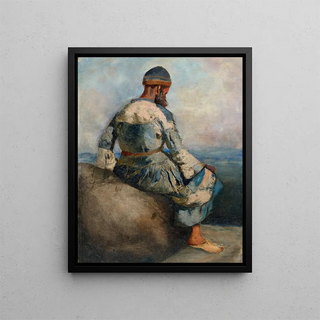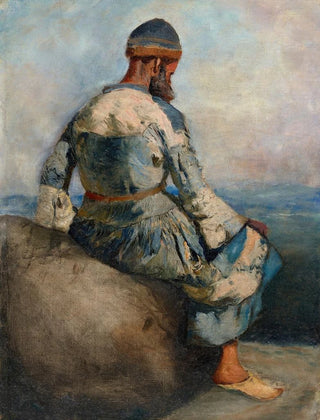Art print | Persian peasant sitting on top of a rock - Edwin Lord Weeks


View from behind

Frame (optional)
The artwork "Paysan persan assis au sommet d'un rocher" by Edwin Lord Weeks invites viewers on a sensory journey into a rich and vibrant culture. Through this depiction, the artist masterfully captures not only a frozen moment in time but also the very essence of a serene daily life. In this scene, a peasant, symbolizing simplicity and popular wisdom, is seated on a rock, contemplating a landscape that seems to stretch infinitely. The warm colors and meticulous details evoke an atmosphere of peace and reflection, offering art enthusiasts a true immersion into the oriental universe of the 19th century.
Style and uniqueness of the work
The uniqueness of this art print lies in how Weeks manages to blend realism and romanticism. His style, characterized by meticulous attention to detail, pays homage to the beauty of Persian landscapes while highlighting the lives of the people who inhabit them. The choice of colors, ranging from soft ochres to deep greens, helps create an ambiance that is both warm and soothing. The peasant, at the center of the composition, is dressed in traditional clothing that tells a story, while the rock on which he sits becomes a symbol of stability and strength. This art print does not merely depict a scene; it invites contemplation and reflection, engaging the viewer to consider the relationship between man and his environment.
The artist and his influence
Edwin Lord Weeks, an American painter of the 19th century, is known for his representations of the Orient, a theme that fascinates him and which he explores through numerous travels. His work is marked by a desire to pay tribute to cultures often little known in the West. By immersing himself in the daily life of Persian peasants, Weeks transcends simple oriental clichés to offer an authentic and poetic vision. His influence extends beyond his own era, inspiring many contemporary and future artists. By incorporating elements of Persian culture into his art, he paves the way for a deeper appreciation of traditions.

Matte finish

View from behind

Frame (optional)
The artwork "Paysan persan assis au sommet d'un rocher" by Edwin Lord Weeks invites viewers on a sensory journey into a rich and vibrant culture. Through this depiction, the artist masterfully captures not only a frozen moment in time but also the very essence of a serene daily life. In this scene, a peasant, symbolizing simplicity and popular wisdom, is seated on a rock, contemplating a landscape that seems to stretch infinitely. The warm colors and meticulous details evoke an atmosphere of peace and reflection, offering art enthusiasts a true immersion into the oriental universe of the 19th century.
Style and uniqueness of the work
The uniqueness of this art print lies in how Weeks manages to blend realism and romanticism. His style, characterized by meticulous attention to detail, pays homage to the beauty of Persian landscapes while highlighting the lives of the people who inhabit them. The choice of colors, ranging from soft ochres to deep greens, helps create an ambiance that is both warm and soothing. The peasant, at the center of the composition, is dressed in traditional clothing that tells a story, while the rock on which he sits becomes a symbol of stability and strength. This art print does not merely depict a scene; it invites contemplation and reflection, engaging the viewer to consider the relationship between man and his environment.
The artist and his influence
Edwin Lord Weeks, an American painter of the 19th century, is known for his representations of the Orient, a theme that fascinates him and which he explores through numerous travels. His work is marked by a desire to pay tribute to cultures often little known in the West. By immersing himself in the daily life of Persian peasants, Weeks transcends simple oriental clichés to offer an authentic and poetic vision. His influence extends beyond his own era, inspiring many contemporary and future artists. By incorporating elements of Persian culture into his art, he paves the way for a deeper appreciation of traditions.






